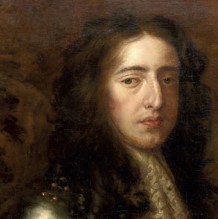‘HUGON COME ERINDWARDS’—JAMES JOYCE’S HUGUENOTS
Published in Features, Issue 3 (May/June 2023), Volume 31By Martin Green
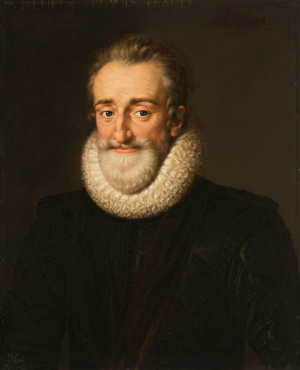
Above: Henry IV by Frans Pourbus the Younger (1610). In 1598 Henri promulgated the Edict of Nantes, which for almost a century underpinned the coexistence of Catholics and Protestants in France. (Royal Collection)
In Finnegans Wake, the main ingredient in Shaun’s ‘stockpot dinner’ is a ‘round steak, very rare, Blong’s best from Portarlington’s Butchery’. The reference is to a butchery operated by a Blong family at the Huguenot settlement in Portarlington in the early 1700s; the Blongs were among the Huguenots (French Protestants) admitted to Ireland after Louis XIV’s revocation of the Edict of Nantes. Joyce drew on Huguenot-related material to support themes such as diversity, tolerance and exile.
FRANCE
Protestantism established a foothold in France in the years following Luther’s challenge to church authority in 1517, but it soon became clear that French Protestants would take a Calvinist rather than a Lutheran path. The Huguenots were initially drawn from the commercial and professional classes. Soon, however, some leading aristocrats (notably members of the Montmorency and Bourbon families) joined their ranks. They now had a leadership cadre with the capacity to mobilise military force. Other leading aristocrats (notably the Guise family) led a militant Catholic faction that aimed to eliminate Protestantism from the kingdom. The Crown and moderate Catholics favoured an exclusively Catholic kingdom but were open to limited compromise for the sake of peace. Extremists on both sides sought support from co-religionists in neighbouring countries.
The result was eight religious wars in the period 1562–98. When Henri III was assassinated in 1589, the next in the line of succession was Henri of Navarre—a Protestant who had commanded Huguenot forces in the earlier wars but who was a moderate in religion and politics. Taking command of Crown forces, Henri IV (as he now was) subdued the contending factions. Huguenots and moderate Catholics were now potentially open to a compromise settlement, but militant Catholics were adamantly opposed to a Protestant king. Henri then converted to Catholicism. After a further period of war and negotiation, all parties acknowledged Henri as king and accepted the Edict of Nantes (1598) as the end-of-war settlement.
The edict gave Huguenots the freedom to practise their religion (with some restrictions), civil and political rights and the right to maintain fortified locations in some Protestant-majority areas. Catholicism was still the dominant religion, but Catholics had to accept that Protestantism would have legal status as a minority religion for the foreseeable future.
In the 1620s, a resurgence of the old tensions produced a Huguenot rebellion. After Louis XIII defeated the rebels, the Peace of Alais (1629) provided for the continuation in force of the edict except that there was now no provision for fortified locations.
The coexistence of Catholics and Protestants continued on this basis until the 1660s, when Louis XIV began to impose increasingly harsh restrictions on Huguenots, culminating in the revocation of the edict in 1685. One of the principal effects of revocation was that perhaps 200,000 Huguenots went into exile. Many others practised their religion secretly, with the result that a substantial Protestant community re-emerged in 1787 when Louis XVI granted complete religious freedom. The exiles included many with military experience who subsequently practised their trade elsewhere in Europe—notably in the service of William of Orange, the Dutch Stadtholder and, from 1689, king of England.
IRELAND
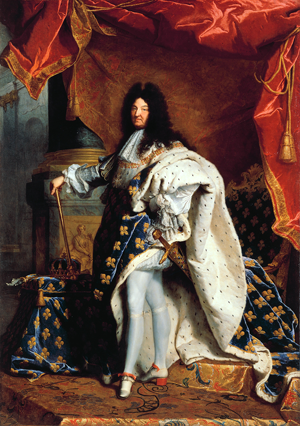
Above: Louis XIV by Hyacinthe Rigaud (1701). In the 1660s Louis began to impose increasingly harsh restrictions on Huguenots, culminating in the revocation of the Edict of Nantes in 1685. Consequently, c. 200,000 Huguenots went into exile.
William was the leader of the coalition of states that opposed Louis XIV in the War of the League of Augsburg (1689–97). His opening move in the ‘War of the Three Kings’ (1689–91)—this being one element within the wider European conflict—was to dispatch an expeditionary force to Ireland under the Duke of Schomberg to confront the French-backed Jacobite forces. The core elements of the force included four Huguenot regiments—perhaps 3,000 officers and men. Schomberg (though of German/English parentage) had been a highly regarded military commander in French service—and on close terms with Louis XIV—until revocation drove him into exile.
The expedition suffered a serious setback at Dundalk, but Huguenot units continued to play an important part in all subsequent phases of the war, including at the Boyne (where William commanded personally following his arrival from England and Schomberg was killed in action). At Aughrim the Huguenot Henri de Massue, Marquis de Ruvigny, is credited with taking the decisive action that secured Williamite victory in the battle and thus, effectively, in the Irish war as a whole. Ruvigny had been the Huguenot representative at the court of Louis XIV until revocation drove him, too, into exile. He was later to become the prime mover behind the settlement at Portarlington and to serve two terms as a lord justice of Ireland (1697–1701 and 1715–17).
THE DIARY AND ACCOUNTS OF ÉLIE BOUHÉREAU
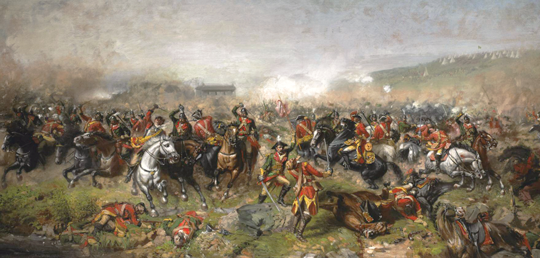 Above: The Battle of Aughrim, by John Mulvany (1885). Huguenot regiments played an important part in the Williamite army at Aughrim and in all phases of the war of 1689–91.
Above: The Battle of Aughrim, by John Mulvany (1885). Huguenot regiments played an important part in the Williamite army at Aughrim and in all phases of the war of 1689–91.
The outcome of the war meant that Ireland continued to be open to Huguenot migrants. Immigration, which had proceeded at modest levels since the 1660s, accelerated and the migrants were now more diverse in character, including ex-soldiers who were settled in Ireland after the conclusion of the war. The publication in 2019 of The diary and accounts of Élie Bouhéreau was the outcome of a fruitful collaboration between Marsh’s Library in Dublin and the Irish Manuscripts Commission. The result (impressively translated and edited) is a valuable addition to the published sources relevant to the Huguenots. Bouhéreau was a post-revocation exile who arrived in Ireland in 1697 to take up a position as Ruvigny’s chief assistant during the latter’s first term as a lord justice; he had previously served Ruvigny in a similar capacity on an English diplomatic/military mission to Savoy-Piedmont (1694–6). In 1701 he became the first librarian at Marsh’s Library, a position he held until his death in 1719.
The entries relating to the Savoy-Piedmont mission and to an earlier one to the Swiss cantons (1689–92) provide insights into the functioning of the coalition opposing Louis XIV. The material relating to Ireland provides details of Bouhéreau’s private life and his official activities, which will be a boon to students of the social history of the period. What the Irish-related material does not do is address directly either the political context of Huguenot immigration into Ireland or the Huguenots’ feelings about their situation in Ireland.
This feature of the diary is evidently a consequence of its being concerned (as diaries often are) with specific events and practical information rather than broader issues. It is also possible, however, that reticence about controversial matters played a part. Contentious issues at the time included official pressure on the Huguenots to conform to Anglicanism and Catholic anger at Ruvigny because of claims (shown by modern research to be inaccurate) that he was a hard-line proponent of the penal laws. The future of the Irish Huguenots was assimilation into the Anglican (and Anglophone) element of Irish society, and this proved to be sufficient to enable them to play a prominent part in the economy and cultural activities whilst avoiding religious and political controversies.
JOYCE
In Ulysses, Bloom sees a piece of red-dyed poplin in a shop window and thinks: ‘… bloodhued poplin: lustrous blood. The Huguenots brought that here. Lacaus esant tara tara. Great chorus that. Taree Tara … Meyerbeer. Tara: bom bom bom.’ Bloom here recalls Giacomo Meyerbeer’s Les Huguenots (1836), an opera with a melodramatic storyline relating to the St Bartholomew’s Day massacres of 1572 in which thousands of Protestants died at the hands of Catholic extremists. His thoughts also reflect the general belief that the Huguenots brought new technologies for the production of poplin and similar products to Ireland. This exaggerates their pioneering role while overlooking their successful participation in already-existing industries. Here and later, Bloom’s thoughts are concerned mainly with the music, but he also registers the violence (‘bloodhued’, ‘lustrous blood’). Elsewhere, he reflects that the name of a popular nineteenth-century singer, Marie Dubedat, suggests Huguenot origins.
In Finnegans Wake the Huguenot-related material is concerned with two main topics—their association with conflict and their contribution to Ireland. In an early passage, which is both preceded and followed by accounts of conflict, we meet ‘Wassaily Booslaeugh of Riesengeborg’, who is described as ‘the first … to bare [sic] arms’. Later, we encounter a ‘Riesengebirger’ in a passage that also includes references to Huguenots. In the shape-shifting world of the Wake, these passages can be seen as referring to the Marquis de Boisseleau, the French commander of Jacobite forces at the first siege of Limerick. A later passage notes that there were also French units (‘hugheknots’) on the Williamite side.
The association of Huguenots with conflict—as both combatants and civilian victims—is reinforced by references to names associated with Huguenot militarism (Montmorency, Rohan), St Bartholomew’s Day, Meyerbeer, Louis XIV’s brutal policy of billeting troops on Huguenot households (‘feeding and sleeping on the huguenottes’), the Boyne, Aughrim and the penal laws (‘the statutes of the Kongbullies’). And allusions to Scullabogue (1798) warn that in conditions of conflict all peoples have the potential to become either the perpetrators or the victims of violence.
The importance of pluralism in this context is emphasised by a mystery document (a ‘mamafesta’) that invokes ‘Annah the Allmaziful, … the Bringer of Plurabilities’; and the idea of a common humanity is advanced by Humphrey Chimpden Earwicker’s ‘universalisation’, by his nickname based on his initials (‘Here Comes Everybody’) and by the phrase ‘the human race extends’. And, complementing this line of thought, references to ‘the confusioning of human races’, ‘our mixed racings’ and ‘Miscegenations on miscegenations’ assert that all claims to racial or national purity are unsustainable.
As for the Huguenots’ contribution to Ireland, their role in the economy is acknowledged in references to poplin and prominent Huguenot business figures such as the La Touche family. Offsetting this positive image somewhat, a reference to ‘leperties’ laddos’ recalls violence between gangs of Protestant and Catholic workers in Dublin in the 1730s and 1740s. The Protestant gang members (known as ‘Liberty Boys’) are commonly said to have been Huguenots but there is no documentary evidence to confirm this.
The cultural contribution is recognised in multiple allusions to leading nineteenth-century writers of Huguenot extraction (Charles Maturin, Dion Boucicault, Joseph Sheridan Le Fanu), while references to Narcissus Marsh recall that Marsh’s Library became a respected centre of European scholarship under Élie Bouhéreau’s stewardship.
BLONG’S BUTCHERY
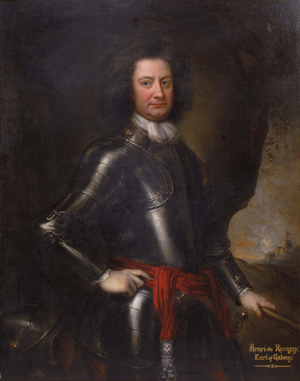 Above: Huguenot Henri de Massue, Marquis de Ruvigny and Earl of Galway—one of William of Orange’s most trusted associates, commanding a cavalry regiment at Aughrim, establishing the settlement at Portarlington, Co. Laois, and serving two terms as lord justice of Ireland.
Above: Huguenot Henri de Massue, Marquis de Ruvigny and Earl of Galway—one of William of Orange’s most trusted associates, commanding a cavalry regiment at Aughrim, establishing the settlement at Portarlington, Co. Laois, and serving two terms as lord justice of Ireland.
The reference to Blong’s butchery resonates across the text through multiple allusions to Laois and Offaly—the counties in which the settlement was located. These include the suggestion that ‘Michael, the etheling lord of Leix and Offaly’, acted as an adviser to ‘William the Conk’ when the latter gave Earwicker his nickname. The source cited for this claim is ‘the learned scholarch Canavan of Canmakenoise [Clonmacnoise, Co. Offaly]’. There is also a suggestion that the early settlers faced difficult conditions: ‘We were but thermites then … Our antheap we sensed as a Hill of Allen, the Barrow for ant people [the Bog of Allen, the River Barrow].’
The implication of the butchery reference is that the Huguenot contribution to Ireland depended not only on prominent figures but also on individuals of modest social standing who provided useful services to local communities—individuals like Claude Blong. Joyce could have learned about Claude and his butchery from the records of the Huguenot church at Portarlington for 1694–1816, published in an edited edition by Thomas Philip Le Fanu in 1908.
These show that Claude Blong (variant spellings include Leblanc and Blanc) operated a butchery at Portarlington from 1700 until (probably) his death in 1754, and that subsequent generations of the family continued the tradition later in the century and in the early 1800s, a tradition that local historians Ronnie Matthews and John Stocks Powell have shown was maintained until at least 1854. Writing in 1999, Matthews notes that Blongs were also active in other businesses and occupations throughout the nineteenth and twentieth centuries and expresses confidence that the Blong name ‘will still be found in the town for many years to come’. The Joyce commentator Donal Manning has argued persuasively that the term ‘Dyoublong?’ links the question of belonging to the name ‘Blong’. Readers who recognise this linkage and who know the history of Blong’s butchery will surely see these passages as insisting that the Irish Huguenots ‘belong’ in Ireland, not anywhere else.
All things considered, therefore, readers will likely understand Joyce’s treatment of his Huguenot-related material as constituting a powerful argument for openness to diversity and immigration, summed up, perhaps, in the phrase ‘hugon come erindwards’.
Martin Greene is an independent researcher who was brought up in Portarlington.
Further reading
C. Caldicott, H. Gough & J.-P. Pittion (eds), The Huguenots and Ireland: anatomy of an emigration (Dún Laoghaire, 1987).
R. Hylton, Ireland’s Huguenots and their refuge, 1662–1745: an unlikely haven (Eastbourne, 2013).
D. Manning, ‘“Hugon come erindwards’’: Finnegans Wake and Ireland’s Huguenots’, Irish Studies Review 27 (1) (February 2019).

















